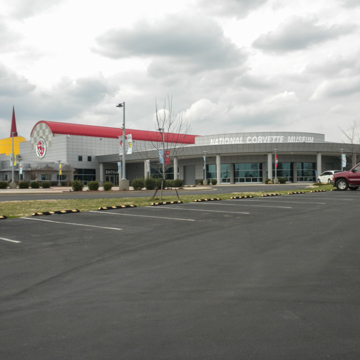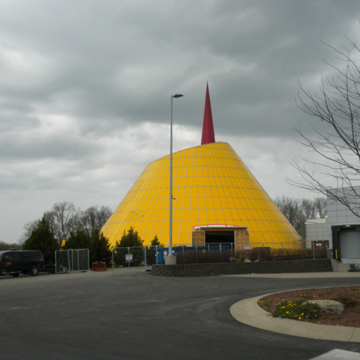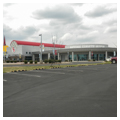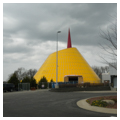The National Corvette Museum proves that the roadside tradition of programmatic architecture is alive and well in Kentucky. Whereas the nearby Wigwam Motel was scaled to slower moving motorists of the 1930s, the National Corvette Museum is scaled to the high-speed instate drivers of today.
The Corvette is cherished as a classic of American automotive design. Introduced by General Motors in 1953, the original Chevrolet Corvette was designed by the revered industrial designer Harley Earl. In 1981, General Motors relocated a Corvette assembly plant from St. Louis to Bowling Green, Kentucky, which is now home to the only Corvette assembly plant in the United States. Several years later, Terry McManmon, active member of the National Corvette Restorers Society, came up with the idea of a Corvette museum. After he had raised over fifteen million dollars to build the museum, both the city and General Motors encouraged him to locate the museum in Bowling Green, near the assembly plant just off Interstate 65.
Architects Kenneth Neumann and Joel Smith were assigned the task of designing a 69,000-square-foot museum that communicates the excitement of the Corvette as a race car and a highly collectible sports car. From the air, the curves of the museum resemble the Corvette’s dashboard. Clad in standardized panels of gray, black, and red, the museum has an industrial sheen that is simultaneously suggestive of the racetrack. The lobby of the museum is designed as an interior street, enclosed in a double-height barrel vault (with a red clad roof). Here, the gift shop, cafe, library and archive all occupy storefronts with real Corvettes parked along the curb. The dramatic centerpiece of the museum is the Skydome, a 130-foot-high, 65-foot-diameter showroom. Cone-shaped and clad in yellow panels, the Skydome is pierced by a bright red spire whose pinnacle, designed to be visible from the interstate, is evocative of the red beacon taillight of the 1961 Corvette. In 2014 a freak sinkhole emerged beneath the Skydome, swallowing eight Corvettes. It has since been repaired. The museum also contains a theater, performance space, and a conference center. Parking areas are arranged around the complex, with one of the lots reserved for visitors driving Corvettes. The Corvette Museum is open to the public.
References
--




